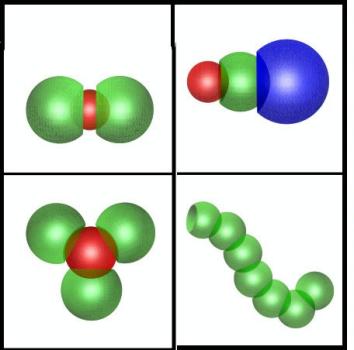Home > Press > NYU Researchers Create “Handshaking” Particles
 |
| NYU physicists have created “handshaking” particles that link together based on their shape rather than randomly. The graphic shows how the researchers developed a “lock and key” mechanism that allows specific particles to join together. Image courtesy of Nature. |
Abstract:
Physicists at New York University have created "handshaking" particles that link together based on their shape rather than randomly. Their work, reported in the latest issue of the journal Nature, marks the first time scientists have succeeded in "programming" particles to join in this manner and offers a type of architecture that could enhance the creation of synthetic materials.
NYU Researchers Create “Handshaking” Particles
New York, NY | Posted on March 26th, 2010"We expect these interactions to offer unprecedented opportunities for engineering ‘smart' composite particles, new functional materials, and microscopic machinery with mobile parts," wrote the researchers, part of NYU's Center for Soft Matter Research.
The process is centered on creating and manipulating colloids—particles suspended within a fluid medium. Colloidal dispersions comprise such everyday items as milk, gelatin, glass, and porcelain.
Working with microscopic particles—25 placed together, end-to-end, would match the width of a strand of human hair—the researchers developed a "lock and key" mechanism that would allow specific particles to join together much in the way Pac-Man would swallow dots in the 1980s video game.
The "key" is any spherical particle. Creating the "lock," however, required a multi-step polymerization process. To do it, the researchers took a droplet of oil and placed it in water. The process resulted in a hardened outer shell, which would then buckle to form an indentation, or Pac-Man mouth, allowing it to bind to the other sphere ("the key").
The work is part of scientists' ongoing efforts to understand and control how particles self-assemble to make new materials. Complex materials cannot be constructed particle by particle; rather, they must be directed to self-assemble, which would produce these materials in an efficient manner. However, manipulating the self-assembly process has proven elusive to scientists because their understanding of how particles interact is limited.
By creating a process by which particles come together to form an aggregate, physicists at NYU's Center for Soft Matter Research have marked a next step in understanding and developing the self-assembly process.
The paper's authors are: Stefano Sacanna and William Irvine, post-doctoral researchers in NYU's Department of Physics, and NYU Physics Professors Paul Chaikin and David Pine.
####
About New York University
More than 175 years ago, Albert Gallatin, the distinguished statesman who served as secretary of the treasury under Presidents Thomas Jefferson and James Madison, declared his intention to establish "in this immense and fast-growing city ... a system of rational and practical education fitting for all and graciously opened to all." Founded in 1831, New York University is now one of the largest private universities in the United States. Of the more than 3,000 colleges and universities in America, New York University is one of only 60 member institutions of the distinguished Association of American Universities.
For more information, please click here
Contacts:
James Devitt
(212) 998-6808
Copyright © New York University
If you have a comment, please Contact us.Issuers of news releases, not 7th Wave, Inc. or Nanotechnology Now, are solely responsible for the accuracy of the content.
| Related News Press |
News and information
![]() Researchers develop molecular qubits that communicate at telecom frequencies October 3rd, 2025
Researchers develop molecular qubits that communicate at telecom frequencies October 3rd, 2025
![]() Next-generation quantum communication October 3rd, 2025
Next-generation quantum communication October 3rd, 2025
![]() "Nanoreactor" cage uses visible light for catalytic and ultra-selective cross-cycloadditions October 3rd, 2025
"Nanoreactor" cage uses visible light for catalytic and ultra-selective cross-cycloadditions October 3rd, 2025
Synthetic Biology
![]() New micromaterial releases nanoparticles that selectively destroy cancer cells April 5th, 2024
New micromaterial releases nanoparticles that selectively destroy cancer cells April 5th, 2024
![]() Rice University launches Rice Synthetic Biology Institute to improve lives January 12th, 2024
Rice University launches Rice Synthetic Biology Institute to improve lives January 12th, 2024
Possible Futures
![]() Spinel-type sulfide semiconductors to operate the next-generation LEDs and solar cells For solar-cell absorbers and green-LED source October 3rd, 2025
Spinel-type sulfide semiconductors to operate the next-generation LEDs and solar cells For solar-cell absorbers and green-LED source October 3rd, 2025
Academic/Education
![]() Rice University launches Rice Synthetic Biology Institute to improve lives January 12th, 2024
Rice University launches Rice Synthetic Biology Institute to improve lives January 12th, 2024
![]() Multi-institution, $4.6 million NSF grant to fund nanotechnology training September 9th, 2022
Multi-institution, $4.6 million NSF grant to fund nanotechnology training September 9th, 2022
Self Assembly
![]() Diamond glitter: A play of colors with artificial DNA crystals May 17th, 2024
Diamond glitter: A play of colors with artificial DNA crystals May 17th, 2024
![]() Liquid crystal templated chiral nanomaterials October 14th, 2022
Liquid crystal templated chiral nanomaterials October 14th, 2022
![]() Nanoclusters self-organize into centimeter-scale hierarchical assemblies April 22nd, 2022
Nanoclusters self-organize into centimeter-scale hierarchical assemblies April 22nd, 2022
![]() Atom by atom: building precise smaller nanoparticles with templates March 4th, 2022
Atom by atom: building precise smaller nanoparticles with templates March 4th, 2022
Discoveries
![]() Researchers develop molecular qubits that communicate at telecom frequencies October 3rd, 2025
Researchers develop molecular qubits that communicate at telecom frequencies October 3rd, 2025
![]() Next-generation quantum communication October 3rd, 2025
Next-generation quantum communication October 3rd, 2025
![]() "Nanoreactor" cage uses visible light for catalytic and ultra-selective cross-cycloadditions October 3rd, 2025
"Nanoreactor" cage uses visible light for catalytic and ultra-selective cross-cycloadditions October 3rd, 2025
|
|
||
|
|
||
| The latest news from around the world, FREE | ||
|
|
||
|
|
||
| Premium Products | ||
|
|
||
|
Only the news you want to read!
Learn More |
||
|
|
||
|
Full-service, expert consulting
Learn More |
||
|
|
||








